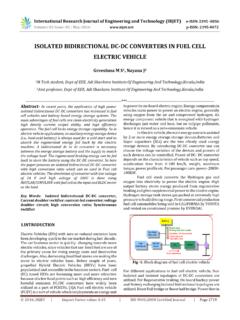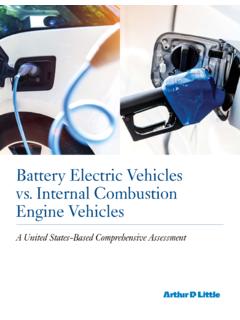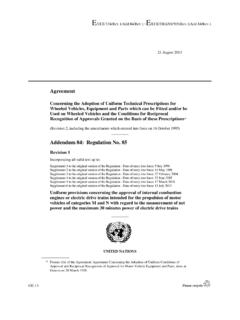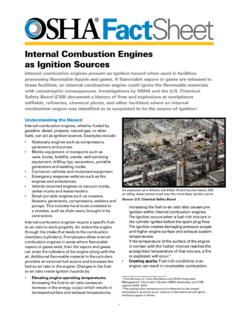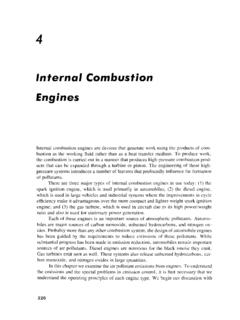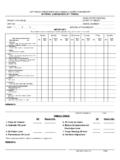Transcription of ANALYSIS OF ENGINE CYLINDER LINERS
1 International Research Journal of Engineering and Technology (IRJET) e-ISSN: 2395 -0056 Volume: 02 Issue: 09 | Dec-2015 p-ISSN: 2395-0072 2015, IRJET ISO 9001:2008 Certified Journal Page 631 ANALYSIS OF ENGINE CYLINDER LINERS K. Srinivasa Rao 1, 2 , 3 , , Krishna 5 , K. Siva Rama Krishna 6 1 Assistant Professor, Mechanical Engineering, Engineering College, Vijayawada, AP, INDIA. 2,3,4,5,6 Final Year Mechanical Engineering, Engineering College, Vijayawada, AP, INDIA. ---------------------------------------- -----------------------------**--------- ---------------------------------------- --------------------Abstract - A CYLINDER Liner or also known as Sleeve is a cylindrical component that is placed in an ENGINE block.
2 It is one of the most important functional parts to make up the interior of an ENGINE and it gives a wear protective surface for piston and piston barrel or bore in which an ENGINE piston moves back and forth may be an integral part of the CYLINDER block, or it may be a separate liner. It is commonly used in gasoline engines, has the disadvantage of not being replaceable. When excessive wear occurs in a block of this type, the CYLINDER must be re-bored or honed. Reconditioning of this type cannot be repeated indefinitely and, in time, the entire block must be replaced. Another disadvantage is the inconvenience, especially in large engines, of having to remove the entire CYLINDER block from a ship in order to recondition the cylinders Key Words: CYLINDER Liner,Piston rings, wear resistance 1.
3 INTRODUCTION A CYLINDER liner or also known as sleeve (Figure 1) is a cylindrical component that is placed in an ENGINE block to form a CYLINDER . It is one of the most important functional parts to make up the interior of an ENGINE and it gives a wear protective surface for piston and piston rings. Figure 1. Cross-section of a CYLINDER in an internal combustion A CYLINDER wall in an ENGINE is under high temperature and high pressure, with the piston and piston rings sliding at high speeds. In particular, since longer service life is required of engines for trucks and buses, cast iron cylinders that have excellent wear-resistant properties are only used for CYLINDER parts Also, with the recent trend of lighter engines, materials for ENGINE blocks have been shifting from cast iron to aluminum alloys. However, as the sliding surface for the inner CYLINDER , the direct sliding motion of aluminum alloys has drawbacks in deformation during operation and wear-resistance.
4 For that reason, cast iron CYLINDER LINERS are used in most cases. What is the purpose of Liner: The barrel or bore in which an ENGINE piston moves back and forth may be an integral part of the CYLINDER block, or it may be a separate sleeve or liner. The first type, common in gasoline engines, has the disadvantage of not being replaceable. When excessive wear occurs in a block of this type, the CYLINDER must be rebored or honed. Reconditioning of this type cannot be repeated indefinitely and, in time, the entire block must be replaced. Another disadvantage is the inconvenience, especially in large engines, of having to remove the entire CYLINDER block from aship in order to recondition the cylinders. For these reasons, diesel engines are constructed with replaceable CYLINDER LINERS .
5 The CYLINDER LINERS we will discuss are representative of those used in diesel engines The material of a liner must withstand the extreme heat and pressure developed within the combustion space at the top of the CYLINDER and, at the same time, must permit the piston and its sealing rings to move with a minimum of friction. Close-grained cast iron is the material most commonly used for liner construction. (Steel, however, is sometimes used.) Some LINERS are plated on the wearing surface with porous chromium, because chromium has greater wear-resistant qualities than other materials. Also the pores in the plating tend to hold the lubricating oil and aid in maintaining the lubrication oil film that is necessary for reduction of friction and wear International Research Journal of Engineering and Technology (IRJET) e-ISSN: 2395 -0056 Volume: 02 Issue: 09 | Dec-2015 p-ISSN: 2395-0072 2015, IRJET ISO 9001:2008 Certified Journal Page 632 1.
6 Formation of sliding surface: The CYLINDER liner, serving as the inner wall of a CYLINDER , forms a sliding surface for the piston rings while retaining the lubricant within. The most important function of CYLINDER LINERS is the excellent characteristic as sliding surface and these four necessary points. anti-galling properties wear on the CYLINDER liner itself wear on the partner piston ring consumption of lubricant 2. Heat transfer: The CYLINDER liner receives combustion heat through the piston and piston rings and transmits the heat to the coolant. As shown in figure 2 Figure 2. Heat transfer 3. Compression gas sealing: The CYLINDER liner prevents the compressed gas and combustion gas from escaping outside. It is necessary that a CYLINDER liner which is hard to transform by high pressure and high temperature in the CYLINDER .
7 As shown in figure 3 air tightness of CYLINDER liner Types of LINERS : CYLINDER LINERS may be divided into two general classifications or types, they are dry and wet LINERS . The dry liner does not come in contact with the coolant. Instead, it fits closely against the wall of the cooling jacket in the CYLINDER block. With the wet liner, the coolant comes in direct contact with the liner. Wet LINERS may have a cooling water space between the ENGINE block and liner, or they may have integral cooling passages. LINERS with integral cooling passages are sometimes referred to as water-jacket LINERS . Dry LINERS Dry LINERS have relatively thin walls compared with wet LINERS (fig. 4). Note that the coolant circulates through passages in the block and does not come in contact with the liner Figure 4 A dry CYLINDER liner (General Motors 71 series) Wet LINERS In wet LINERS that do not have integral cooling passages, the water jacket is formed by the liner and a separate jacket which is a part of the block.
8 (See fig. 3-11.) A static seal must be provided at both the combustion and crankshaft ends of the cylinders to prevent the leakage of coolant into the oil pan sump, or combustion space. Generally, the seal at the combustion end of a liner consists of either a gasket under a flange or a machined fit. Rubber or neoprene rings generally form the seal at the crankshaft end of the liner. LINERS of this type are constructed to permit lengthwise expansion and contraction. The walls of a wet liner must be strong enough to withstand the full working pressure of the combustion gases International Research Journal of Engineering and Technology (IRJET) e-ISSN: 2395 -0056 Volume: 02 Issue: 09 | Dec-2015 p-ISSN: 2395-0072 2015, IRJET ISO 9001:2008 Certified Journal Page 633 Figure 5 Cross section of a wet CYLINDER liner.
9 DESIGN OF LINER The model we had use is FORD3600 ,it is an indian based automobile model. The dimensions of this model are as follows: Inner diameter: mm Outer diameter: mm Collar diameter: mm Total length : 211-212 mm Collar width : 8-9 mm By using this dimension we have drawn the solid 3D model in the ANSYS 15 workbench . The solid model is as follows: Figure : 6 After the geometry part is drawn , the solid model is used for meshing for further ANALYSIS . By selecting all faces of the model the mesh is generated automatically .The mesh generated is shown in figure Figure : 7 After the meshing is over, the boundary conditions are given. The boundary conditions like forces, pressures, thermal conditions, supports, contacts for the model. Here we had taken the pressure developed for the diesel engines about 5-8 Mpa.
10 The temperature developed in the ENGINE CYLINDER is above 300 degree Celsius. For a liner the outer surface is fixed , because it is to be fitted into the ENGINE CYLINDER block so for this reason we had taken the outer surface of the LINERS are fixed. All the boundary conditions are shown in the following figures International Research Journal of Engineering and Technology (IRJET) e-ISSN: 2395 -0056 Volume: 02 Issue: 09 | Dec-2015 p-ISSN: 2395-0072 2015, IRJET ISO 9001:2008 Certified Journal Page 634 Figure: 8 Upto this the design part of the liner is completed. All the boundaries that are given for the model are , pressure that applied is 8 Mpa ,it is applied on the internal at internal surface of the liner.








